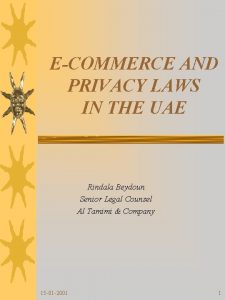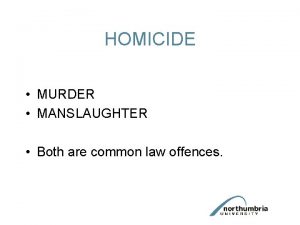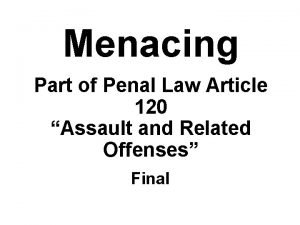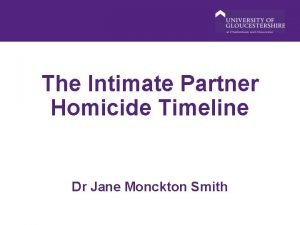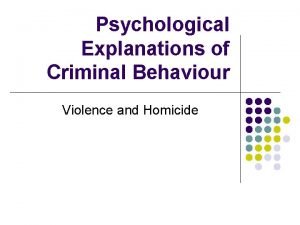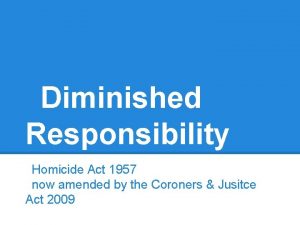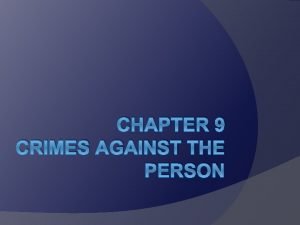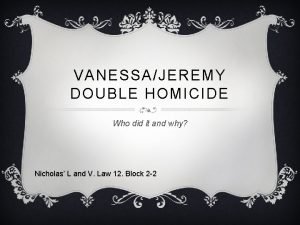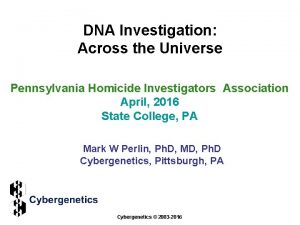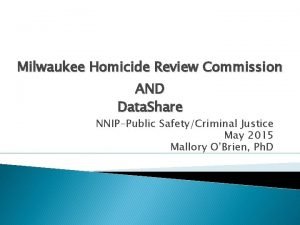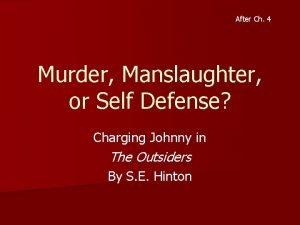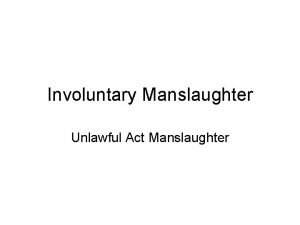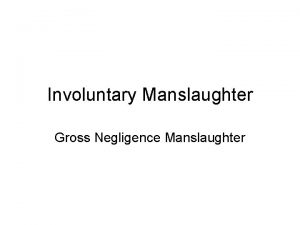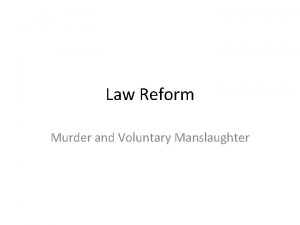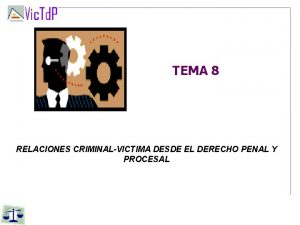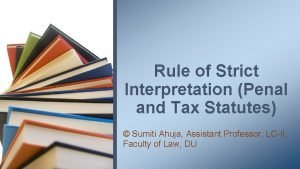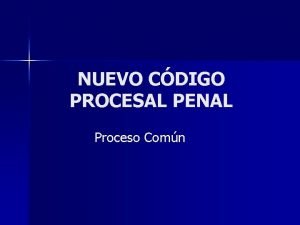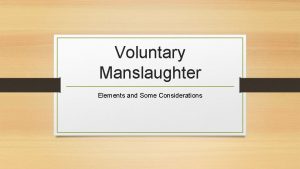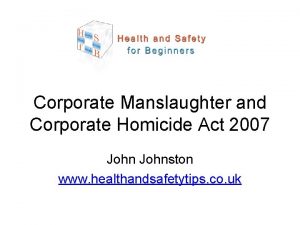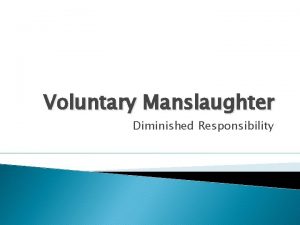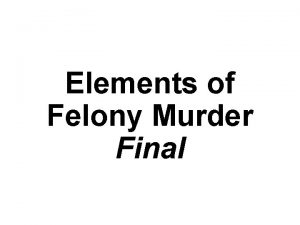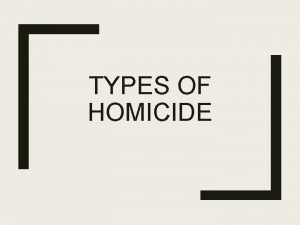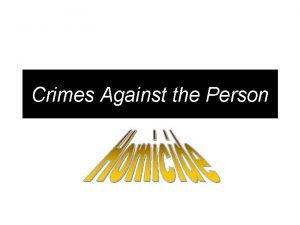Homicide Manslaughter Penal Law Article 125 FINAL Manslaughter













![The Basic Offense: Manslaughter-2 • Statute (Penal Law § 125. 15 [1]): • A The Basic Offense: Manslaughter-2 • Statute (Penal Law § 125. 15 [1]): • A](https://slidetodoc.com/presentation_image_h2/53e69cea43608b74b5d914a21083e121/image-14.jpg)


![Manslaughter - 1 • Statute (Penal Law § 125. 20 [1]): • with intent Manslaughter - 1 • Statute (Penal Law § 125. 20 [1]): • with intent](https://slidetodoc.com/presentation_image_h2/53e69cea43608b74b5d914a21083e121/image-17.jpg)










- Slides: 27

Homicide: Manslaughter (Penal Law Article 125) FINAL

Manslaughter • First, I will define common terms • Second I will break the following assault offenses into elements: • Manslaughter 2 • Manslaughter 1

Manslaughter: Common Definitions • Homicide • the manner in which a person behaves which causes the death of a person or an unborn child with which a female has been pregnant for more than twenty-four weeks under circumstances constituting murder, manslaughter in the first degree, manslaughter in the second degree, criminally negligent homicide, abortion in the first degree or selfabortion in the first degree. (Penal Law § 125. 00)

Manslaughter: Common Definitions • Recklessly • A person behaves RECKLESSLY with respect to a death when that person engages in conduct which creates or contributes to a substantial and unjustifiable risk that another person's death will occur, and when he or she is aware of and consciously disregards that risk, and when that risk is of such nature and degree that disregard of it constitutes a gross deviation from the standard of conduct that a reasonable person would observe in the

Manslaughter: Common Definitions • Recklessly • Where there is evidence of voluntary intoxication on the part of the defendant, a person also acts recklessly when he or she creates such a risk but is unaware of that risk solely by reason of his or her voluntary intoxication. (Penal Law § 125. 15[1])

Manslaughter: Common Definitions • Person • when referring to the victim of a homicide, means a human being who has been born and is alive. (Penal Law § 125. 05)

Manslaughter: Common Definitions • Physical Injury • means damage of physical condition or substantial pain. (Penal Law § 10. 00[9])

Manslaughter: Common Definitions • Serious Physical Injury • means deterioration of a person's physical condition which creates a substantial risk of death or which causes death or serious and protracted disfigurement, protracted impairment of health or protracted loss or impairment of the function of any bodily organ. (Penal Law § § 125. 20[1]; 10. 00[10])

Manslaughter: Common Definitions • Intent • means cognizant objective or purpose. Thus, a person acts with intent to cause serious physical injury to another when that person's conscious objective or purpose is to cause serious physical injury to another person. (Penal Law § 125. 20[1])

Manslaughter: Common Definitions • Intent “transferred” • it is not required that the person who dies be the same person who was intended to be injured. (Penal Law § 125. 20[1])

Manslaughter: Common Definitions • Intent “as applied to Manslaughter 1” • means mindful objective or purpose. Thus, a person acts with intent to cause physical injury to a person less than eleven (11) years old when that person's attentive objective or purpose is to cause physical injury to a person less than eleven (11) years old. (Penal Law § 125. 20[4])

Manslaughter: Common Definitions • Recklessly “as applied to Manslaughter 1” • engages in conduct which creates a meaningful, unjustifiable, and grave risk that serious physical injury to a person less than eleven (11) years old will occur, and when he or she is aware of and consciously disregards that risk, and when that risk is of such nature and degree that disregard of it constitutes a gross deviation from the standard of conduct that a reasonable person would observe in the situation. (Penal Law § 125. 20[4])

Manslaughter: Common Definitions • Recklessly “as applied to Manslaughter 1” • Where there is indication of voluntary intoxication on the part of the defendant, add: A person also acts recklessly when he or she creates such a risk but is unaware of that risk solely by reason of his or her voluntary intoxication. (Penal Law § 125. 20[4])
![The Basic Offense Manslaughter2 Statute Penal Law 125 15 1 A The Basic Offense: Manslaughter-2 • Statute (Penal Law § 125. 15 [1]): • A](https://slidetodoc.com/presentation_image_h2/53e69cea43608b74b5d914a21083e121/image-14.jpg)
The Basic Offense: Manslaughter-2 • Statute (Penal Law § 125. 15 [1]): • A person is guilty of Manslaughter in the Second Degree when that person recklessly causes the death of another person.

The Basic Offense: Manslaughter-2 • Elements 1. The defendant caused the death of the victim; and 2. That the defendant did so recklessly.

The Basic Offense: Manslaughter - 2 to Manslaughter 1 • Elevators • Degree of Recklessness or Carelessness • Age of Victim • Intent or Resolve
![Manslaughter 1 Statute Penal Law 125 20 1 with intent Manslaughter - 1 • Statute (Penal Law § 125. 20 [1]): • with intent](https://slidetodoc.com/presentation_image_h2/53e69cea43608b74b5d914a21083e121/image-17.jpg)
Manslaughter - 1 • Statute (Penal Law § 125. 20 [1]): • with intent to cause serious physical injury to another person, he causes the death of such person or of a third person.

The Offense: Manslaughter-1 • Elements 1. The defendant caused the death of the victim. 2. That the defendant did so with the intent to cause serious physical injury to a specific victim.

Manslaughter -1: (Intentional Homicide Under Influence of Extreme Emotional Disturbance) • Statute (Penal Law § 125. 20 [2]): • With intent to cause the death of another person, he causes the death of such person or of a third person under circumstances which do not constitute murder because he acts under the influence of extreme emotional disturbance, as defined in paragraph (a) of subdivision one of section 125. The fact that homicide was committed under the influence of extreme emotional disturbance constitutes a mitigating circumstance reducing murder to manslaughter in the first degree and need not be proved in any

The Offense: Manslaughter-1 (Intentional Homicide Under Influence of Extreme Emotional Disturbance) • Elements 1. That on or about a specific date, in a specific county, the named defendant, caused the death of a specific victim. 2. That the defendant did so with the intent to cause the death of a specific victim.

Affirmative Defense Article 40 - New York Penal Law, section 40. 15 • A new fact or set of facts that operates to defeat a claim even if the facts supporting that claim are true. • Allowed under rules of Criminal Procedure. • Must be asserted by showing that there are facts in addition to the ones in the indictment or information charging the defendant and that those additional facts are legally sufficient to excuse the defendant.

Affirmative Defense Article 40 - New York Penal Law, section 40. 15 In any prosecution for an offense, it is an Affirmative Defense that when the defendant engaged in the proscribed conduct, he lacked criminal responsibility by reason of mental disease or defect. Such lack of criminal responsibility means that at the time of such conduct, as a result of mental disease or defect, he lacked substantial capacity to know or appreciate either: • 1. The nature and consequences of such conduct; or • 2. That such conduct was wrong.

Extreme Emotional Disturbance Defense • A defendant cannot establish an extreme emotional disturbance defense without evidence that he or she suffered from a mental infirmity not rising to the level of insanity at the time of the homicide, typically manifested by a loss of self-control. • And not all mental infirmities merit a manslaughter charge based on extreme emotional disturbance (Casassa, 49 NY 2 d at 677).

To prove such an Affirmative Defense, a defendant must demonstrate • 1) First, that he or she acted under the influence of an extreme emotional disturbance and, • 2) Second, that there was a reasonable explanation or excuse for that disturbance. People v Roche, 98 NY 2 d 70 (2002)

To prove such an Affirmative Defense, a defendant must demonstrate • The First, subjective element is met if there is evidence that defendant’s conduct at the time of the incident was actually influenced by an extreme emotional disturbance. • The Second is an objective element and requires proof that defendant’s emotional disturbance was supported by a reasonable explanation or excuse. People v Roche, 98 NY 2 d 70 (2002)

The Offense: Manslaughter-1 (Recklessly Causing Child's Death; Intent to Cause Child Physical Injury) • Statute (Penal Law § _125. 20 [4]_): • Under New York Penal Law, a person is guilty of Manslaughter in the First Degree when, being eighteen (18) years old or more and with the resolve to cause physical injury to a person less than eleven (11) years old, he or she recklessly engages in conduct which creates a meaningful peril of serious physical injury to such person and thereby causes the death of such person.

The Offense: Manslaughter-1 (Recklessly Causing Child's Death; Intent to Cause Child Physical Injury) • Elements 1. The defendant, caused the death the victim who is under the age of 11 years old; 2. That the defendant did so by carelessly engaging in conduct which created a grave risk of serious physical injury to a specific victim; 3. That the defendant acted with the intent to cause physical injury to a specific victim; and 4. That, at such time, the defendant was eighteen (18) years old or more.
 Article 378 of the uae penal code
Article 378 of the uae penal code Common law manslaughter
Common law manslaughter Menacing penal law
Menacing penal law Domestic homicide timeline
Domestic homicide timeline Overt vs covert behavior
Overt vs covert behavior Khi n
Khi n Homicide act 1957
Homicide act 1957 Site:slidetodoc.com
Site:slidetodoc.com Starkweather homicide 1958
Starkweather homicide 1958 Double homicide
Double homicide Arizona homicide investigators association
Arizona homicide investigators association Milwaukee homicide review commission
Milwaukee homicide review commission Newton's first law and second law and third law
Newton's first law and second law and third law Si unit of newton's first law
Si unit of newton's first law V=k/p
V=k/p P=k/v
P=k/v Unlawful act manslaughter definition
Unlawful act manslaughter definition Manslaughter definition in the outsiders
Manslaughter definition in the outsiders Example of involuntary manslaughter
Example of involuntary manslaughter Voluntary manslaughter
Voluntary manslaughter Gross negligence manslaughter actus reus
Gross negligence manslaughter actus reus Diminished responsibility
Diminished responsibility Involuntary manslaughter examples
Involuntary manslaughter examples Radical pluralist account of penal crisis
Radical pluralist account of penal crisis Pareja penal y pareja criminal
Pareja penal y pareja criminal Interpretation and construction
Interpretation and construction Derecho penal sustantivo
Derecho penal sustantivo Procedimiento común penal guatemalteco
Procedimiento común penal guatemalteco
